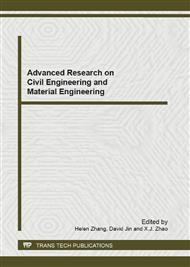p.89
p.94
p.99
p.103
p.107
p.112
p.119
p.125
p.129
Cantilever Construction Optimization of Cable-Stayed Bridge with Hybrid Bridge Deck System and Building Materials in Civil Engineering
Abstract:
This paper describes the basic characteristics of the hybrid bridge deck system made up of two building materials include orthotropic steel deck system and the composite beam deck system, and the problem of excessive horizontal displacement on the bridge tow in cantilever construction as the different weight of the steel bridge deck panel and concrete one. Based on the self-balancing and self-anchoring principle of cable-stayed bridge, two optimizing methods of that adding weight or bridge deck paving after main beam enclosing, were proposed. Numerical simulation of the conventional construction procedure of Beijiang Bridge in Guizhou-Guangzhou Railway was carried out compared with the optimizing procedures proposed. The results show that the max horizontal displacement on the bridge tow is 12.5 cm in the construction period of normal procedure of cantilever construction, which is about 2 cm with the optimizing procedures proposed. Cantilever construction optimization eliminates the hidden dangers by excessive horizontal displacement of the bridge tow, and put forwards a reasonable construction program.
Info:
Periodical:
Pages:
107-111
Citation:
Online since:
September 2012
Authors:
Price:
Сopyright:
© 2012 Trans Tech Publications Ltd. All Rights Reserved
Share:
Citation:


